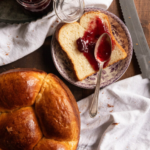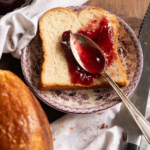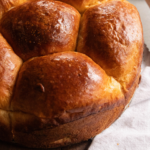This recipe for sourdough brioche is light, tender, and buttery, a long fermented take on the classic French enriched loaf. It takes a little planning ahead, but it’s worth every minute of waiting! Sourdough brioche is perfect for toasting, French toast, and making sandwiches.
Sourdough brioche is everything bread should be. The tangy sourdough flavor, rich, buttery crumb, and soft, golden crust come together to create a loaf that’s both complex in flavor and irresistibly fluffy in texture.
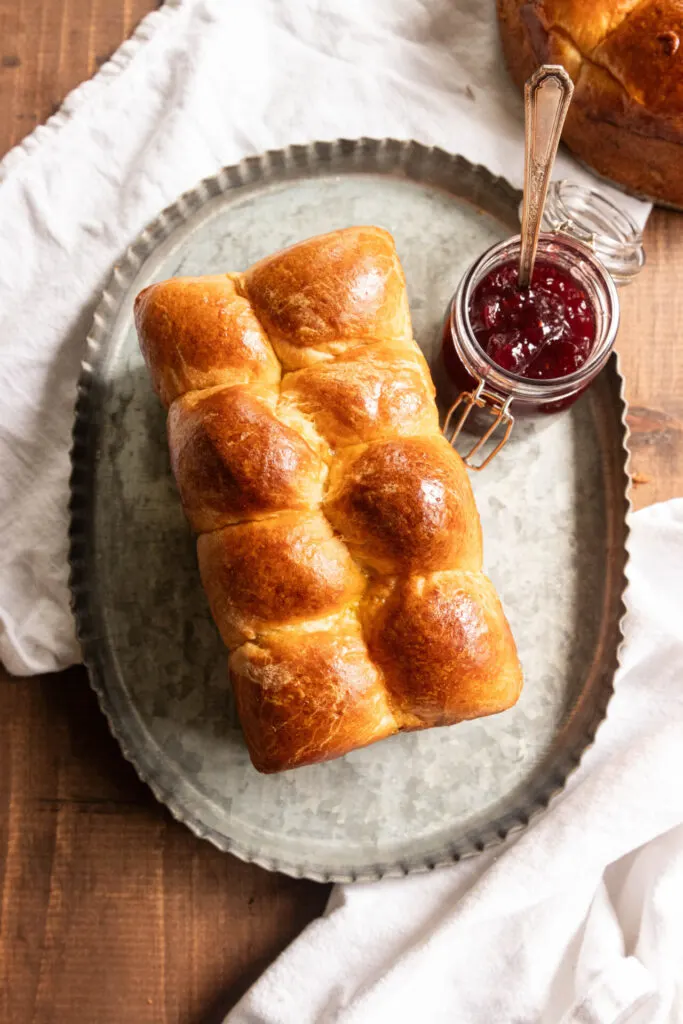
At first glance, sourdough brioche might seem a bit daunting, a recipe better left to seasoned bakers. And while this may not be the first bread you ever want to make, it’s a very achievable, versatile recipe that you can absolutely master.
This version is made with a tangzhong (more on that in a minute), which not only makes the loaf softer, it gives a longer shelf life before it turns stale. I’ve been applying this method in different recipes, and I’m in love with the results!
Sourdough brioche is a celebration of simple, quality ingredients, and whether enjoyed toasted for breakfast or used to make the ultimate gourmet grilled cheese sandwich, it’s sure to become a staple in your kitchen. Dust off your apron, fire up your oven, and let’s get baking!

What is Brioche?
Brioche is an enriched, lightly sweetened yeast bread of French origin. The dough is made rich and tender with eggs, milk, and a lot of butter, yielding a crumb that’s soft and pillowy.
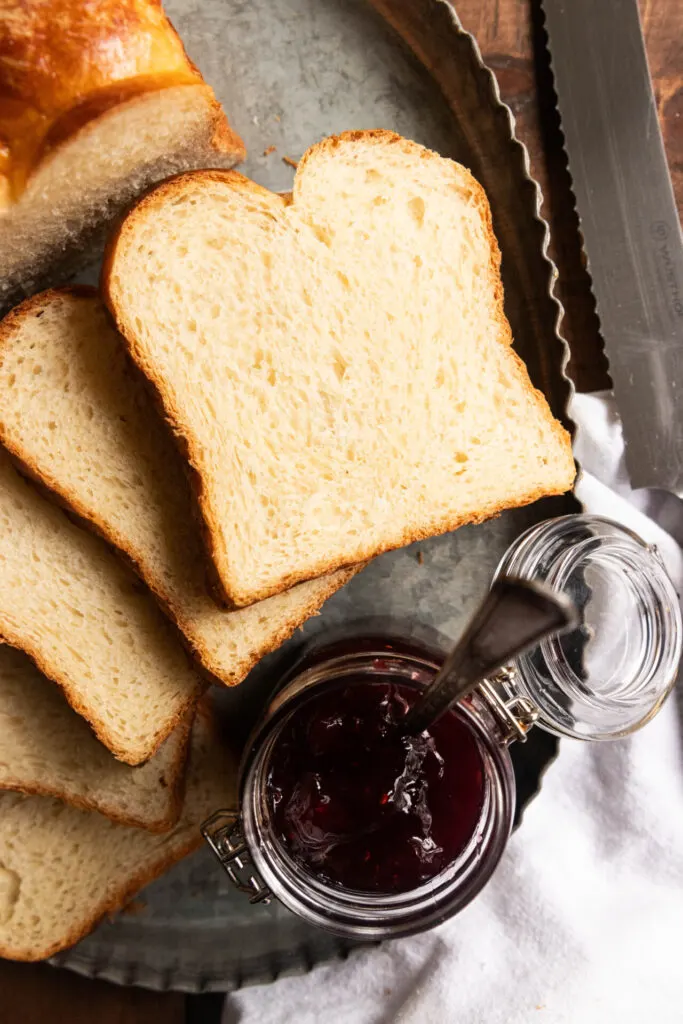
What is a Tangzhong?
It also has a tangzhong, which is a cooked milk and flour paste that will be added to the dough as a way to incorporate more liquid and give you a softer loaf that doesn’t stale as quickly. It’s a technique developed in Japan with countless applications, but this sourdough loaf is my favorite. This Cook’s Illustrated article and video on what a tangzhong is and how to use it in breads has a LOT of helpful information if you want to get all nerdy with the baking science.
Ways to Use Sourdough Brioche
There are so many fabulous ways to enjoy brioche.
- It can always be sliced and spread with rich butter, and perhaps topped with some strawberry freezer jam.
- Make Sourdough French Toast–this is one of my personal favorites! It can also be used for casseroles like this Apple French Toast Casserole.
- Divide the recipe into 8 dough balls and bake them on a baking sheet to make hamburger buns. You can even sprinkle some sesame seeds on top after applying the egg wash!
- Slice and toast it for a killer BLT. Or really any sandwich is instantly elevated by being made on brioche.
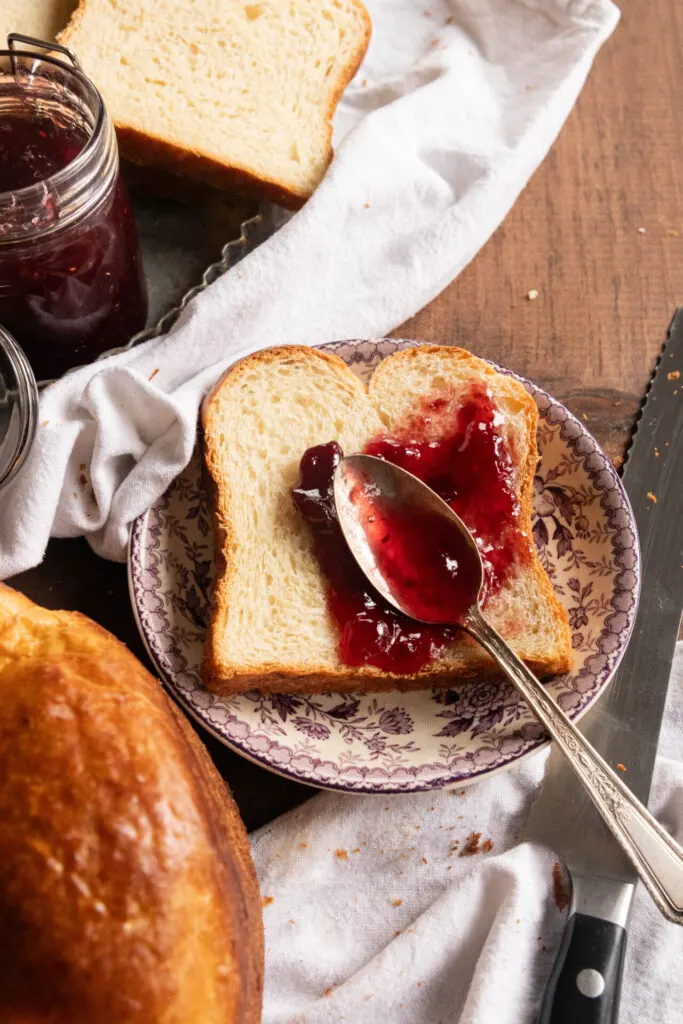
Looking for Other Creative Sourdough Recipes?
There are so many creative recipes for using your sourdough starter! Whether it’s sourdough bagels, bread bowls for soup, biscuits, or even cake, you can find all my favorites here.
Schedules for Sourdough Brioche
Because of the longer rise times for sourdough, there are a couple of schedules you can follow. Both work great, but I prefer the first because I can watch the dough all day and decide when I want it to go in the refrigerator. But follow whichever works best for your schedule–it’s really quite flexible!
Schedule 1
- Feed Your Starter just before going to bed at night. You can also make your tangzhong the night before and store
- Mix the brioche dough after making the tangzhong in the morning when the starter is bubbly and active.
- The first rise will happen during the day, when you can watch it and pop it in the refrigerator when it has doubled.
- Chill the dough overnight.
- Shape the dough when you get up in the morning, and let it take it’s second rise during the day.
- Bake the dough when it’s risen, usually 2-3 hours after shaping.
Schedule 2
- Feed your starter in the late morning/early afternoon, about 6-8 hours before you want to make your bread dough
- About an hour before bed, make the tangzhong and mix your bread.
- The first rise will take place overnight
- When you wake up in the morning, put the dough in the refrigerator
- Shape the bread about 4-6 hours later, then give it it’s second rise
- Bake the bread
This schedule is a little bit riskier, since you’ll be fast asleep and won’t be able to keep an eye on your brioche dough. You risk it being over risen, but if your kitchen is cool, you should be good.
How to Make Sourdough Brioche
For the Tangzhong:
In a small saucepan, whisk together the whole milk and flour until the mixture is smooth. Place the pan over medium low heat and cook it, whisking constantly.
Continue to cook and stir until the mixture has thickened to a paste. This should take 5-7 minutes. Remove the tangzhong from the heat, move it to the mixer bowl, and allow it to cool.
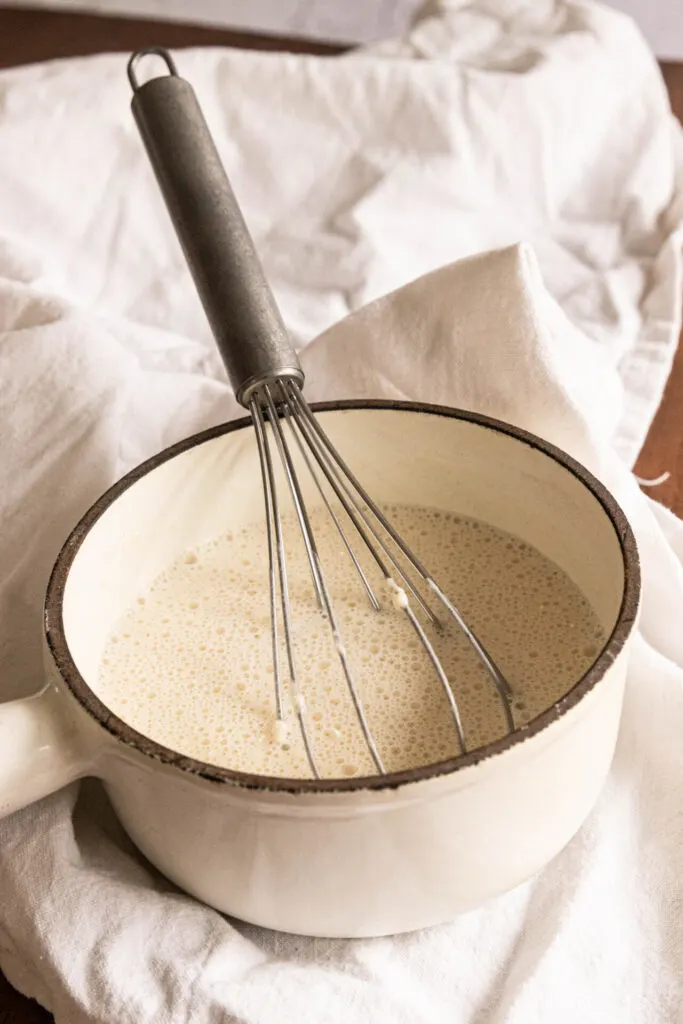
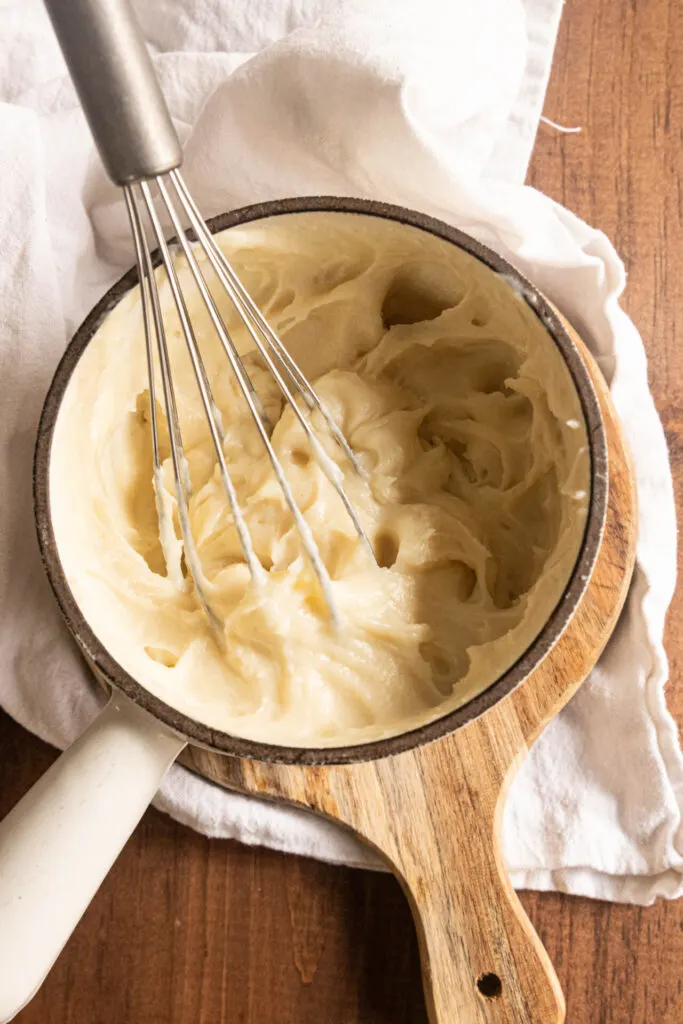
For the Sourdough Brioche Dough:
Butter a 1 pound loaf pan, preferably a metal one. Attach a dough hook to your stand mixer.
In the bowl of the stand mixer, combine the tangzhong, milk, sugar, eggs, and sourdough starter. Mix them until the eggs are smooth. The mixture may be slightly globulous and not completely smooth. That’s just fine! It’ll all become cohesive when you’ve added the flour.

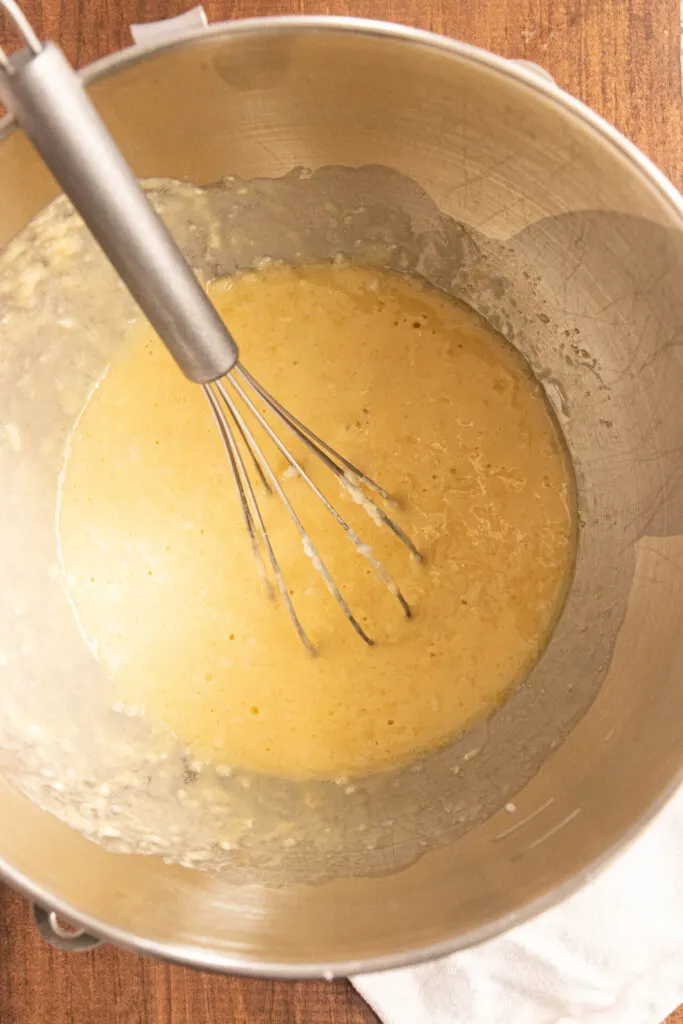
In a separate bowl, whisk together the flour and salt. Add them to the wet ingredients and mix on medium speed until all of the flour is incorporated.
The dough should be soft and won’t pull away from the sides of the bowl. However, if it’s not holding any shape, add flour a tablespoon at a time until the dough is a soft but workable consistency.
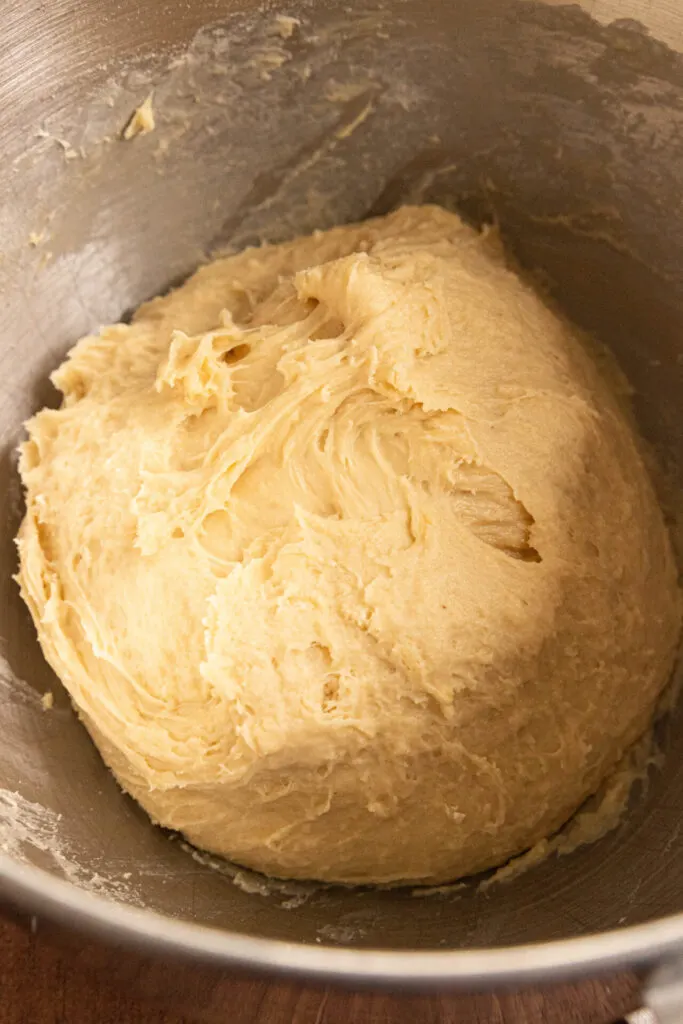
With the mixer still kneading, add the soft butter a tablespoon at a time until it’s all mixed into the dough. Take your time adding it in, allowing each piece to thoroughly mix in before adding more. This process should take 7-10 minutes, so don’t rush! and definitely don’t add all the butter at once, or melt it–the texture of your dough can be ruined.
Once all of the butter is incorporated into the dough, allow the dough to knead on medium speed for another 5 minutes.
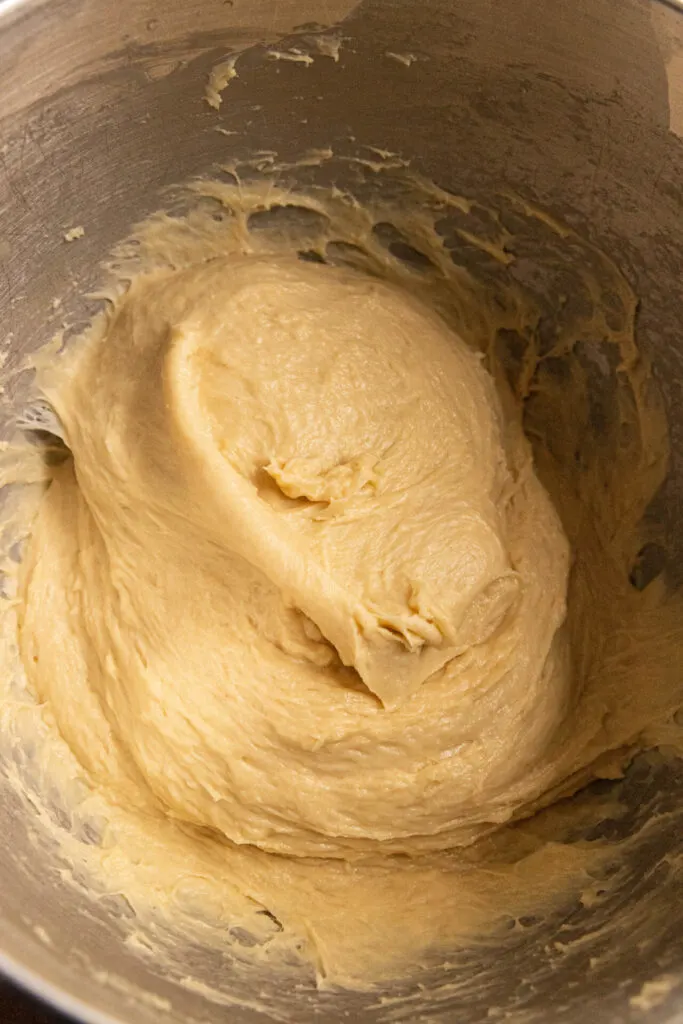
The First Rise (aka Bulk Proof)
When the kneading is finished, use a bowl scraper or rubber spatula to remove the dough to the buttered bowl. Cover it with plastic wrap, a bowl cover, or a (wait for it)…. plastic shower cap.
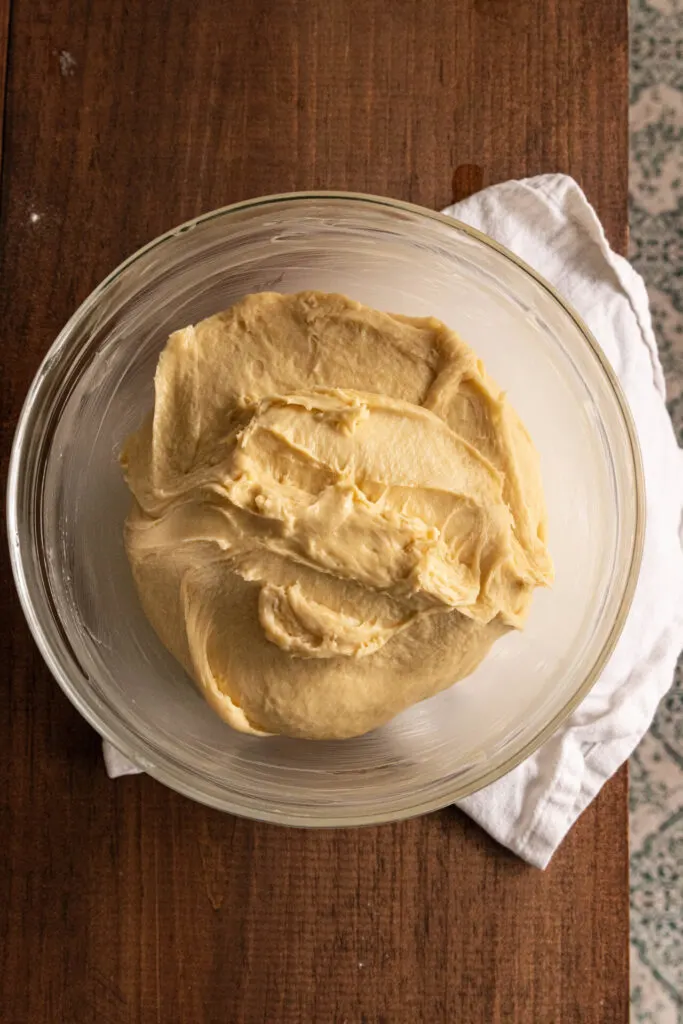
Allow it to rise in a warm, draft-free area for 6-8 hours, or until it’s about doubled in size. Place it in the refrigerator for at least 4 hours, or overnight, to allow the butter to firm up. This makes the dough manageable for the shaping process, which is coming up next.
It’s worth noting that you won’t see much activity in the loaf for the first couple of hours. In fact, I thought my dough wasn’t going to rise at all the first time I made this. But have faith, keep waiting, and that dough will double soon enough.
Shaping the Brioche Into a Loaf
Traditionally, brioche is shaped in a brioche à tête, like this beauty from which translates to head of brioche. But if you don’t happen to have a brioche mold on hand (I don’t), we’re going to make an equally pretty loaf in a loaf pan.
Your final dough weight will be approximately 1250 grams. Turn the dough out onto a lightly floured surface. Divide it into equal halves, then each half into 8 equal portions. You’ll have 16 small portions of about 78 grams each.
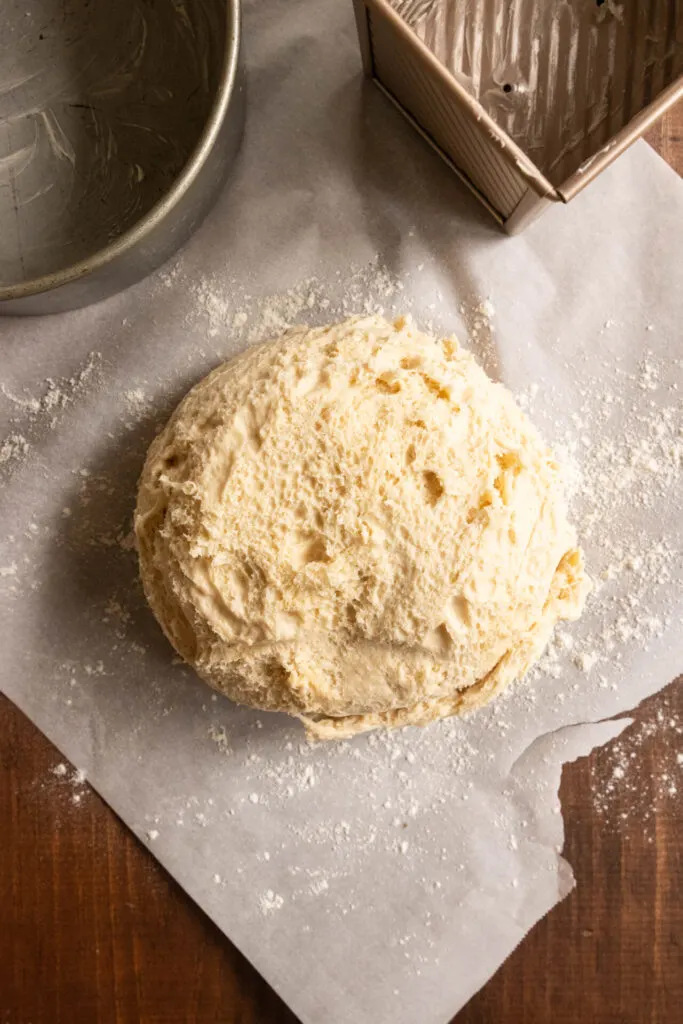
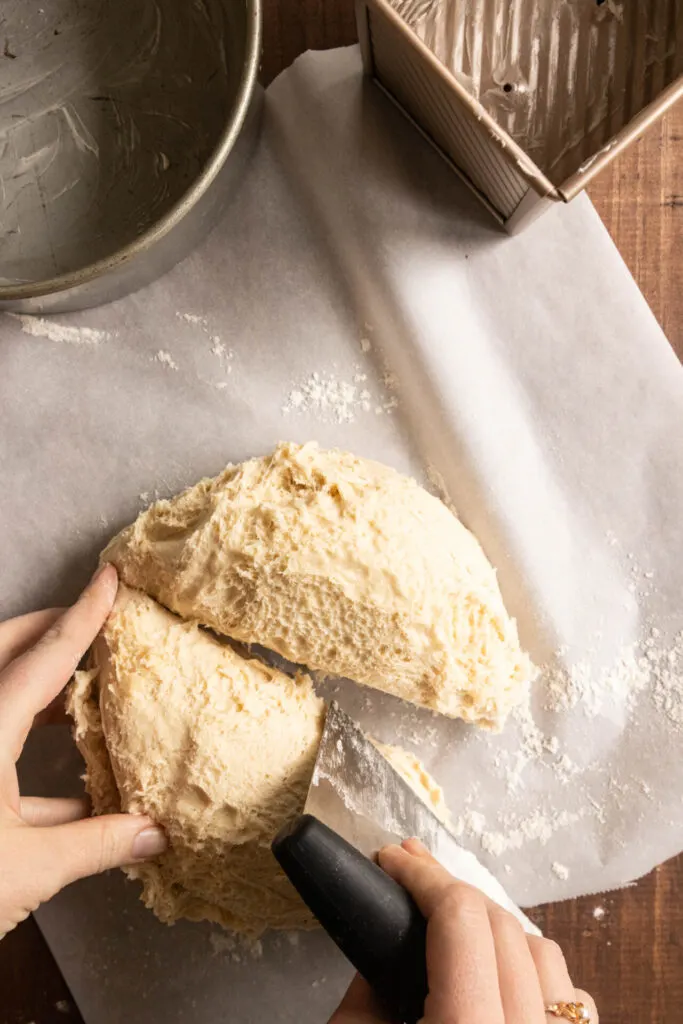
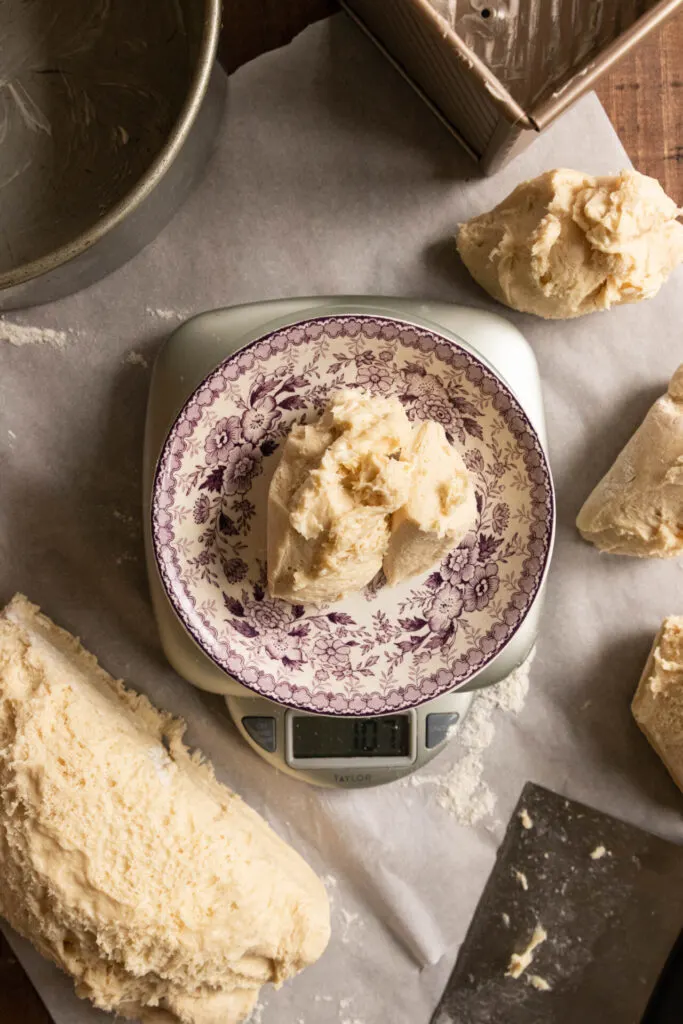
Shape each portion into a rough ball, the press it out gently. Fold it in thirds one direction like a letter, then repeat the folds the opposite direction. You should end up with a small ball.
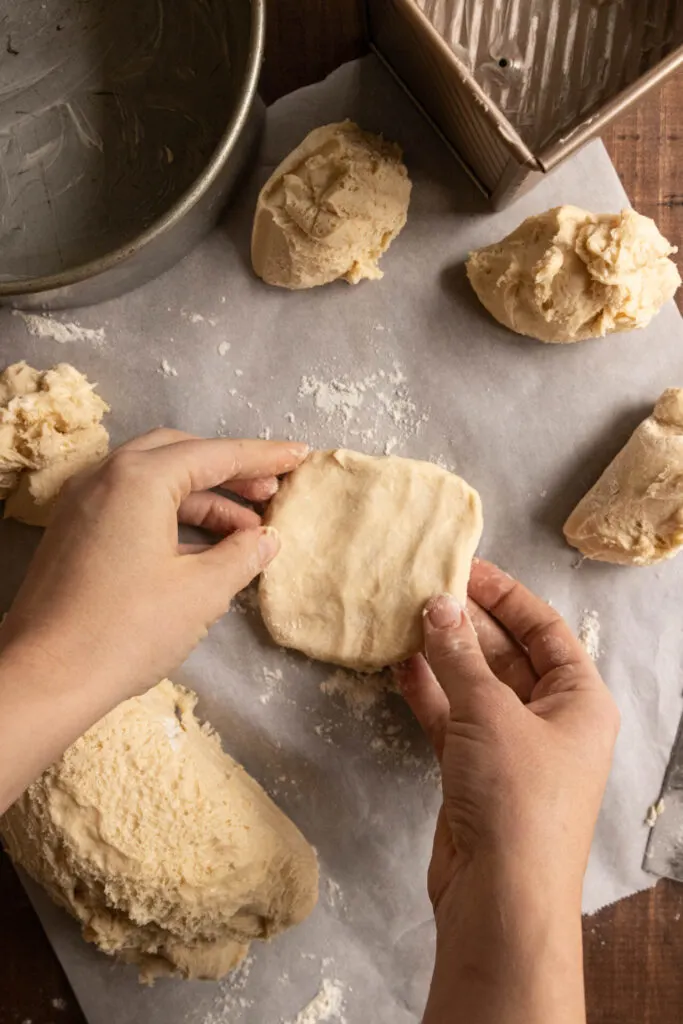
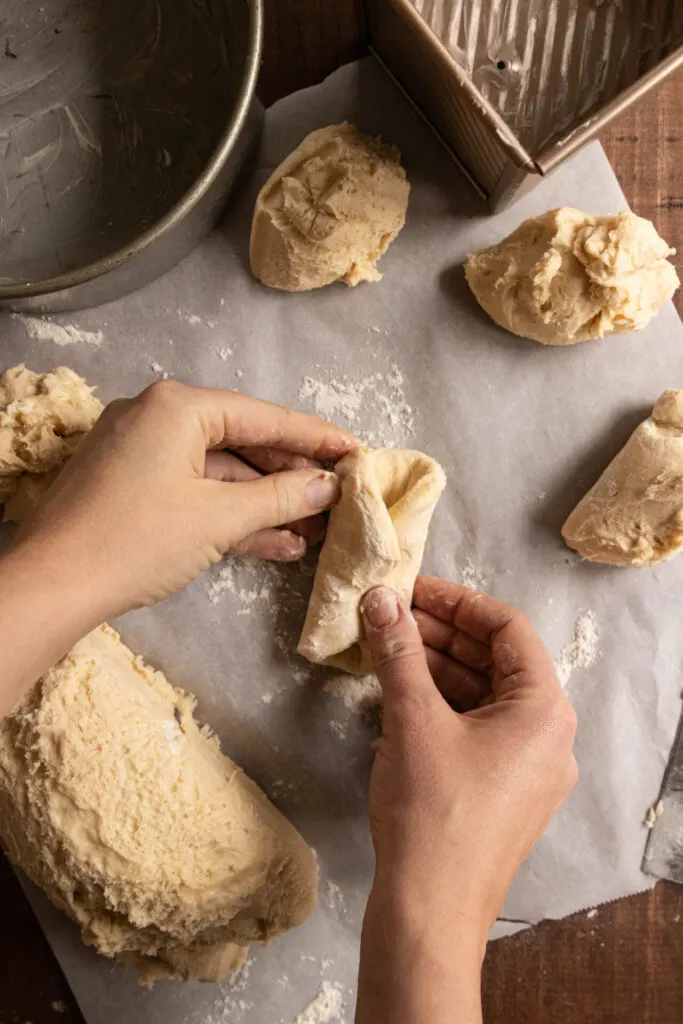
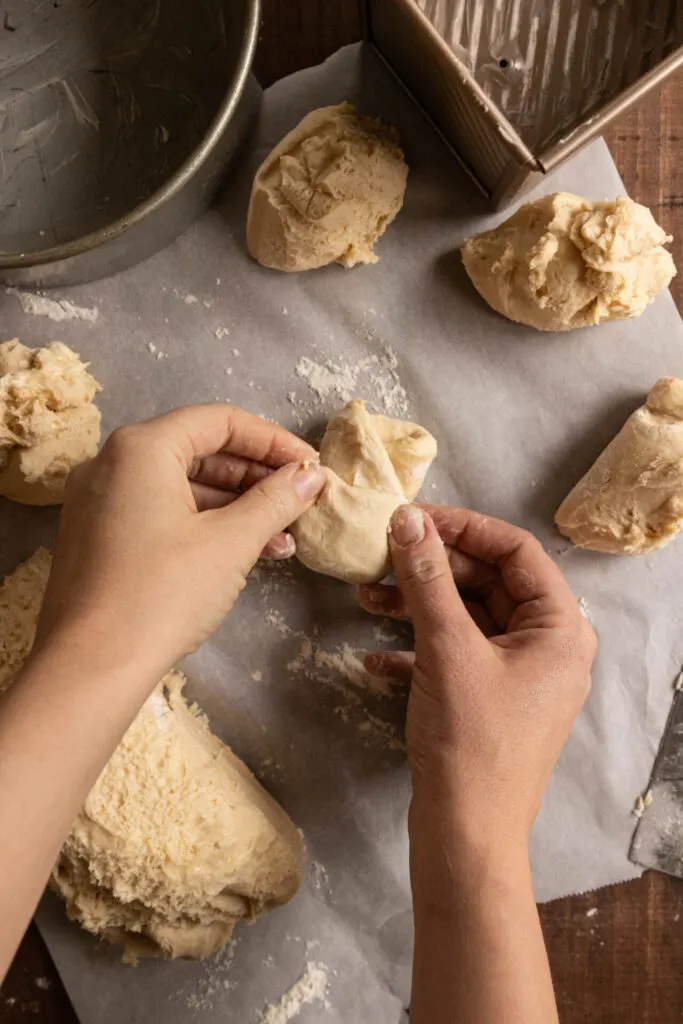
Pinch the undersides of the dough ball together. Cup your hand around the ball and push it along the surface, creating tension on the outside of the dough ball.
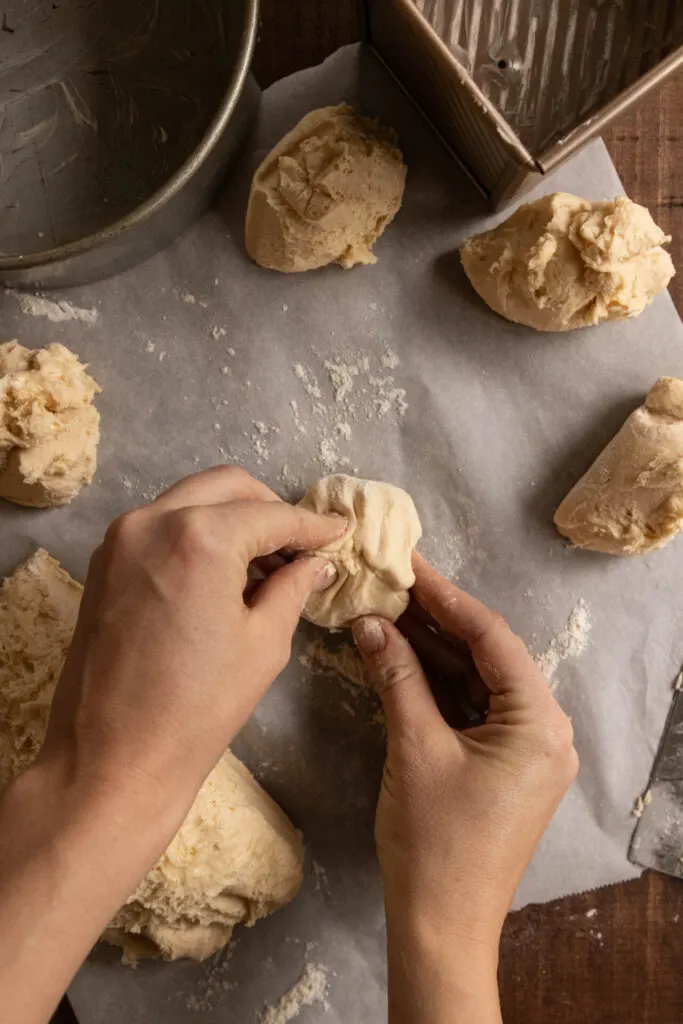
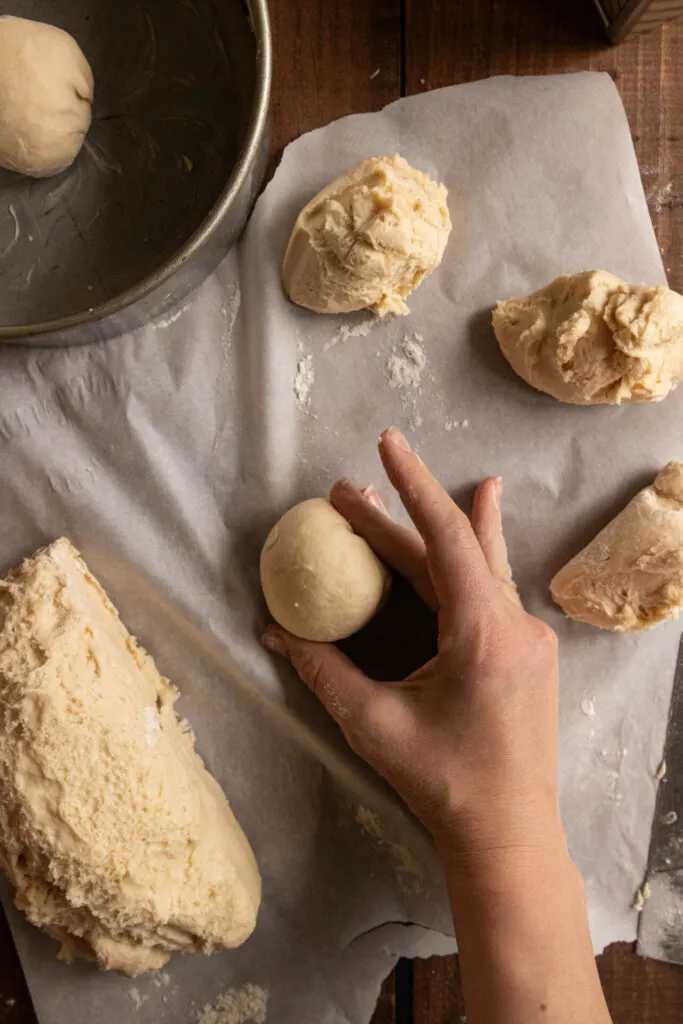
Place eight dough balls each into 2 buttered loaf pans, preferably metal ones. You can place them in two even rows, or put them in a staggered pattern. Either way, the finished loaf will be beautiful!
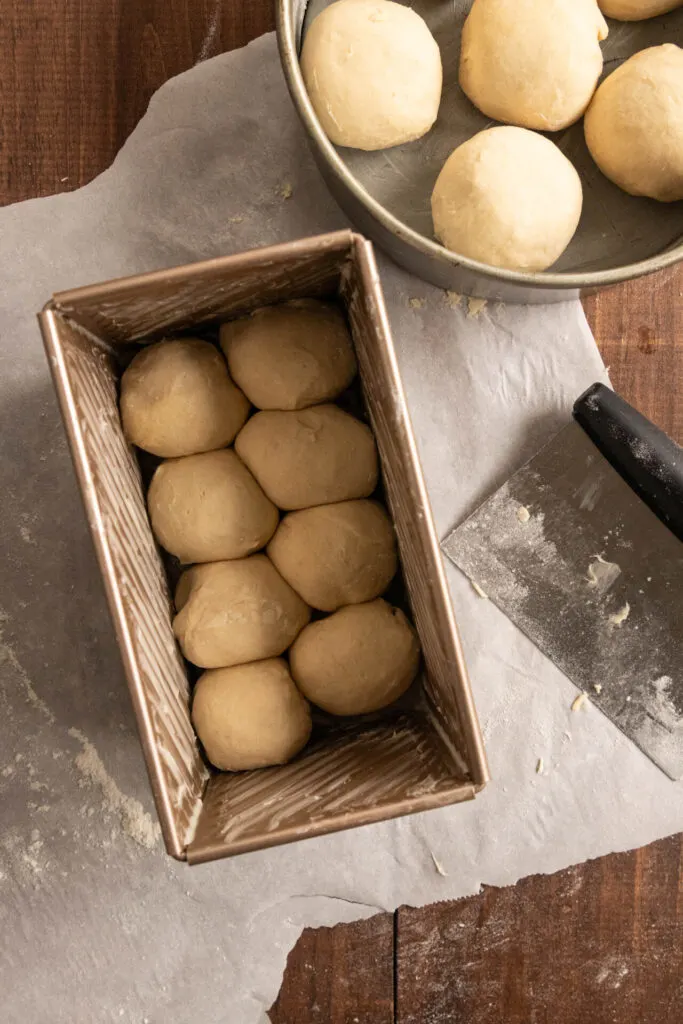
Second Rise
Loosely cover the loaf pan with plastic wrap. Allow the loaf to rise until nearly doubled. It should jiggle slightly if you shake the pan. Brush the top with an egg wash.
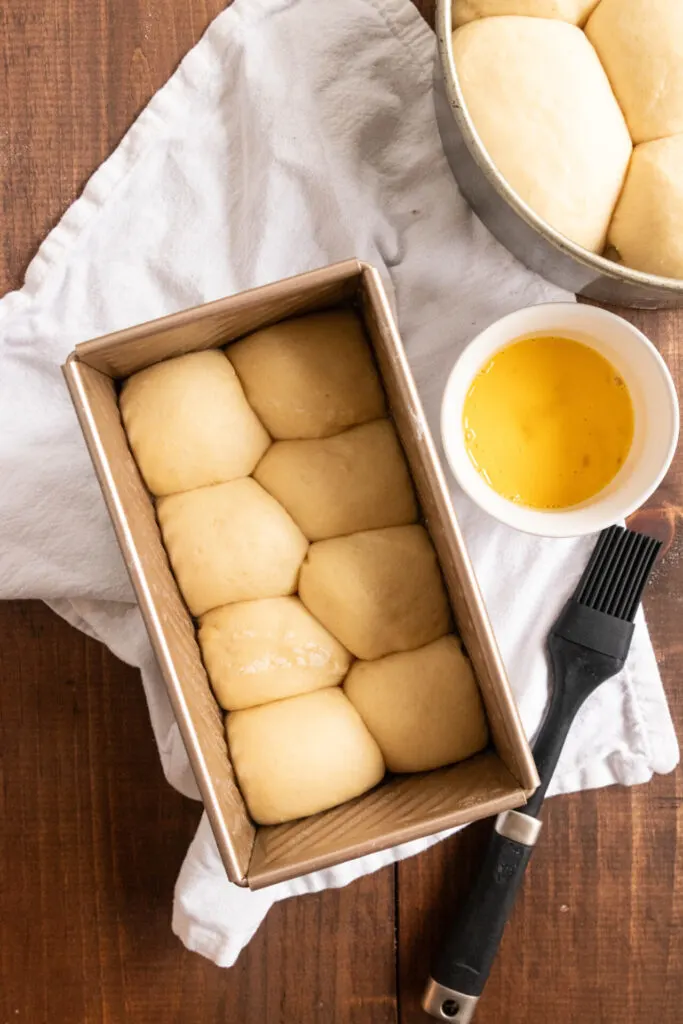

Baking the Brioche
Preheat the oven to 400°. Place the bread in the oven and bake for 15 minutes. This gives the yeast an initial boost and helps the loaf to rise beautifully.
Turn the oven down to 375° and continue to bake for another 20-25 minutes, or until the loaf is a deep golden brown. The internal temperature, which can be measured with a probe thermometer, should be between 180° and 200°.
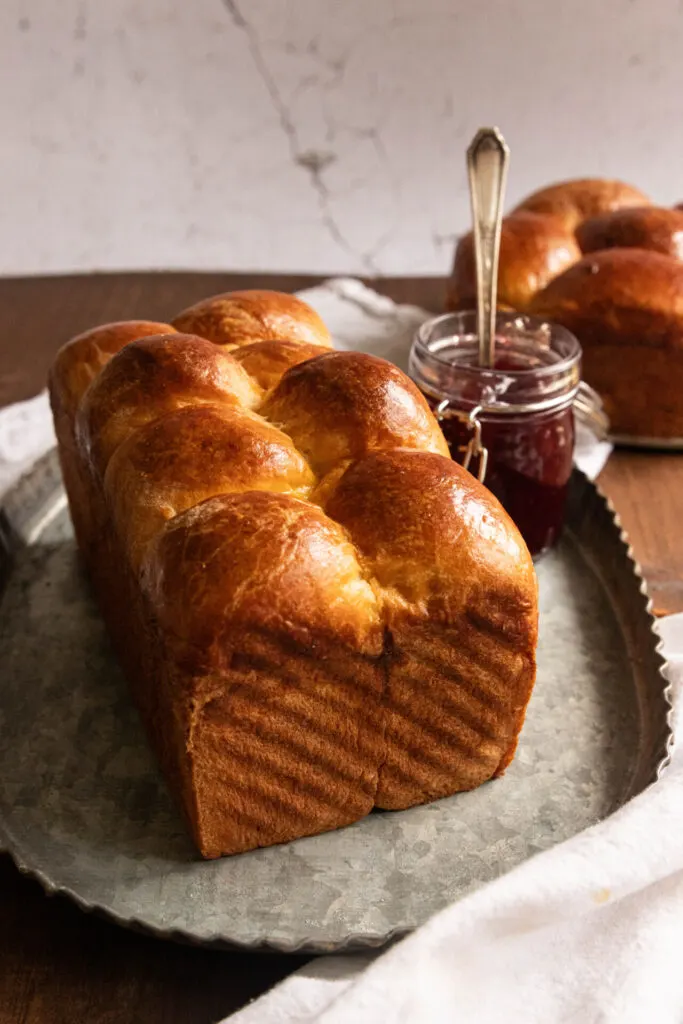
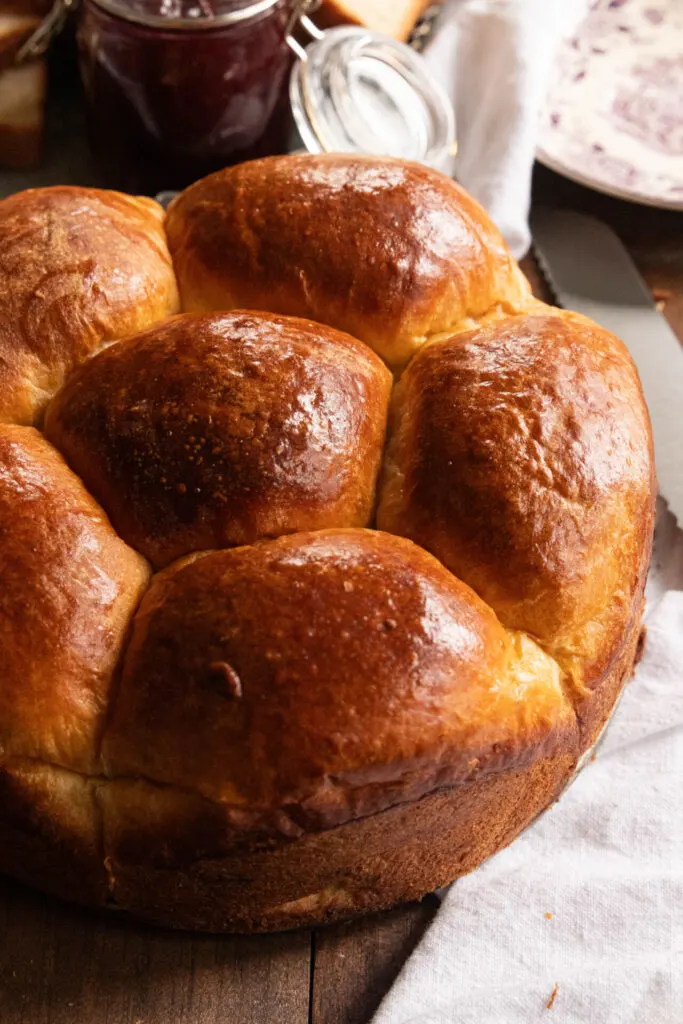
Remove the bread from the oven and let it sit in the pan for 10-15 minutes. Turn it out of the pan onto a cooling rack.
Other Ways to Shape Brioche
Sourdough Brioche Dinner Rolls
Divide the dough into 12 pieces (each will be a little over 100 grams). Follow the same method to fold and roll each piece of dough into a ball. Grease 2 8″ or 9″ round pans (springform or cake pans work well), and place half of the dough pieces into each.
Cover the pans, let them rise at room temperature for 2-4 hours depending on how warm your kitchen is. You want them to be puffy, and the dough to not spring back immediately if you gently tap it with a finger.
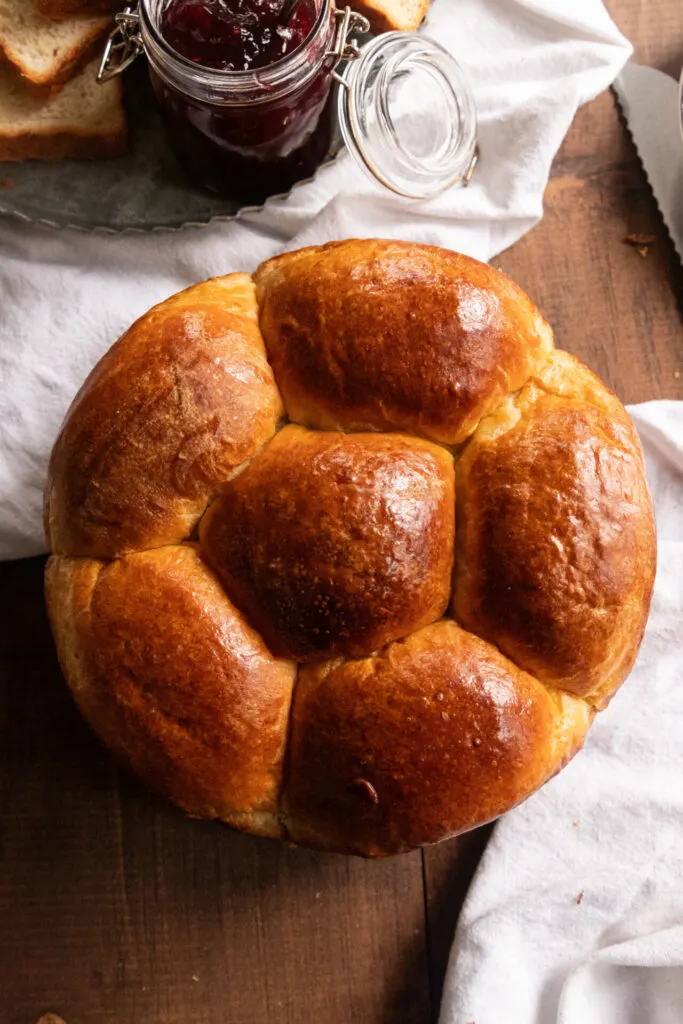
Preheat the oven to 400°, and apply an egg wash to the tops of the rolls. Bake the rolls for 15 minutes, then reduce the heat to 350° and bake for another 20-25 minutes, or until the outside is a deep, golden brown color.
Remove them from the oven and allow them to cool for 45 minutes to an hour before slicing.

Sourdough Brioche Hamburger Buns
Divide the dough into 8 portions, then shape them into rough balls. Press each one out until it’s between 1/2″ and 1″ thick, then fold it in thirds like a letter. Turn and fold it in thirds again the other way, then pinch the seams on the bottom.
Place the ball of dough on the counter, cup your hand around it, and move it in a swirling motion, stretching and pulling the dough a bit as you do. This creates slight tension across the top, helping create a good shape as the bun rises and bakes.
Allow the brioche buns to rise until they’re almost doubled, then egg wash and bake at 375° for 20-23 minutes, or until the tops are a deep golden brown. Allow them to cool completely before slicing them open.
Braided Sourdough Brioche Loaf
After the first rise and chill, divide the dough into 3 or 4 equal portions. Weigh them to make sure they’re all the same weight, then roll them into ropes on a lightly floured surface. The ropes should be about 12″-14″ long.
Braid the ropes into a loaf, depending on how many strands you have. There are great tutorials on YouTube for 3 strand braid, a 4 strand braid, and a round 4 strand braid.
Cover the loaf for it’s second rise, cover it with egg wash, and bake it at 400° until it’s a deep golden brown, with an internal temperature of about 200° Fahrenheit.
Print
Sourdough Brioche
Description
This recipe for sourdough brioche is light, tender, and buttery, a long fermented take on the classic French enriched loaf.
Ingredients
For the Tangzhong
- 306 grams (approx. 1 1/4 cup) whole milk
- 68g (1/2 cup) all-purpose flour
For the Sourdough Brioche
- All of the Tangzhong
- 60 grams(1/4 cup/2.1 fl. oz.) whole milk
- 50 grams (1/4 cup) granulated sugar
- 3 large (150 grams) eggs
- 114 grams (1/2 cup) active, bubbling sourdough starter
- 10 grams (1 1/2 teaspoons) fine sea salt
- 439 grams (3 1/4 cups) all-purpose flour
- 142 grams (10 tablespoons) unsalted butter, very soft
Instructions
For the Tangzhong:
In a small saucepan, whisk together the whole milk and flour until the mixture is smooth. Place the pan over medium low heat and cook it, whisking constantly.
Continue to cook and stir until the mixture has thickened to a paste. This should take 5-7 minutes. Remove the tangzhong to a clean bowl and allow it to cool.
For the Sourdough Brioche Dough:
In the bowl of the stand mixer, combine the tangzhong, milk, sugar, eggs, and sourdough starter. Mix them until the eggs are smooth. The mixture may be slightly globulous and not completely smooth. That’s just fine! It’ll all become cohesive when you’ve added the flour.
In a separate bowl, whisk together the flour and salt. Add them to the wet ingredients and mix on medium speed until all of the flour is incorporated.
The dough should be soft and won’t pull away from the sides of the bowl. However, if it’s not holding any shape, add flour a tablespoon at a time until the dough is a soft but workable consistency.
With the mixer still kneading, add the soft butter a tablespoon at a time until it’s all mixed into the dough. Take your time adding it in, allowing each piece to thoroughly mix in before adding more. This process should take 7-10 minutes, so don’t rush! and definitely don’t add all the butter at once, or melt it–the texture of your dough can be ruined.
Once all of the butter is incorporated into the dough, allow the dough to knead on medium speed for another 5 minutes.
The First Rise (aka Bulk Proof)
When the kneading is finished, use a bowl scraper or rubber spatula to remove the dough to the buttered bowl. Cover it with plastic wrap, a bowl cover, or a (wait for it)…. plastic shower cap.
Allow it to rise in a warm, draft-free area for 6-8 hours, or until it’s about doubled in size. Place it in the refrigerator for at least 4 hours, or overnight, to allow the butter to firm up. This makes the dough manageable for the shaping process, which is coming up next.
Shaping the Brioche Into a Loaf
Traditionally, brioche is shaped in a brioche à tête, like this beauty from which translates to head of brioche. But if you don’t happen to have a brioche mold on hand (I don’t), we’re going to make an equally pretty loaf in a loaf pan.
Your final dough weight will be approximately 1250 grams. Turn the dough out onto a lightly floured surface. Divide it into equal halves, then each half into 8 equal portions. You’ll have 16 small portions of about 78 grams each.
Shape each portion into a rough ball, the press it out gently. Fold it in thirds one direction like a letter, then repeat the folds the opposite direction. You should end up with a small ball.
Pinch the undersides of the dough ball together. Cup your hand around the ball and push it along the surface, creating tension on the outside of the dough ball.
Place eight dough balls each into 2 buttered loaf pans, preferably metal ones. You can place them in two even rows, or put them in a staggered pattern. Either way, the finished loaf will be beautiful!
Second Rise
Loosely cover the loaf pan with plastic wrap. Allow the loaf to rise until nearly doubled. It should jiggle slightly if you shake the pan. Brush the top with an egg wash.
Baking the Brioche
Preheat the oven to 400°. Place the bread in the oven and bake for 15 minutes. This gives the yeast an initial boost and helps the loaf to rise beautifully.
Turn the oven down to 375° and continue to bake for another 20-25 minutes, or until the loaf is a deep golden brown. The internal temperature, which can be measured with a probe thermometer, should be between 180° and 200°.
Remove the bread from the oven and let it sit in the pan for 10-15 minutes. Turn it out of the pan onto a cooling rack.
Notes
- It’s worth noting that you won’t see much activity in the loaf for the first couple of hours of the first rise. In fact, I thought my dough wasn’t going to rise at all the first time I made this. But have faith, keep waiting, and that dough will double soon enough.
- There are several ways to shape the brioche, such as hamburger buns or dinner rolls. I’ve detailed how to do that in the blog post.



